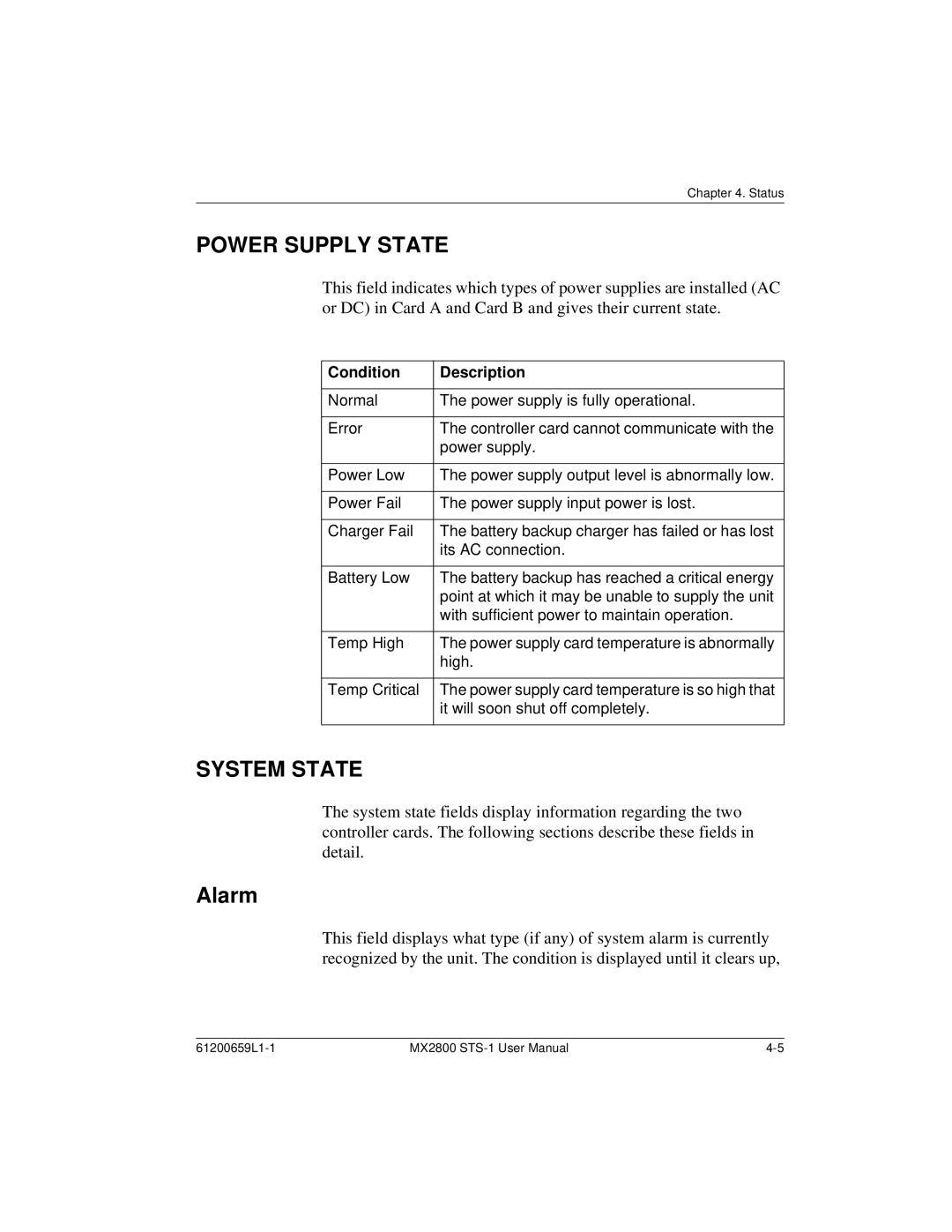MX2800 STS-1
Trademark Information
REN FIC Usoc
Canadian Emissions Requirements
Canadian Equipment Limitations
Important Safety Instructions
Limited Product Warranty
Customer Service, Product Support Information, and Training
Repair and Return
61200659L1-1
Table of Contents
Configuration
Restore Defaults
Status
Statistics
Diagnostics
Index Index-1
Table of Contents Xviii
List of Figures
List of Figures
List of Tables
List of Tables Xxii
Product Overview
Introduction
Controller Card 11 Redundancy
STS-1 Pointers
STS-1 Overview
STS-1 Framing
Virtual Tributaries VT
Transport Overhead TOH
STS-1 Synchronous Payload Envelope SPE
Snmp
Unit Timing
Agent
Telnet
Network Manager
TL1
Breakout Panel P/N 1200291L1
Battery Backup P/N 4175043L2
Available Options
Adtran Shipments Include
UNPACK, INSPECT, Power UP
Receiving Inspection
Power Loss Recovery
Power Up
Backup system or equivalent
DC Connector Symbol Definitions
Alert user when connected to the 4175043L2 battery
Installation and Operation
Be sure to install the flanges with the screws provided
Rackmount Installation
Cable
Connecting the Breakout Panel
Front View Rear View
Function
Rear Panel
Modem Port
Noncritical and Critical Alarm Connectors
LAN Port
DSX-1/E1 Interfaces
Power Connection
Network Interfaces
Establishing Terminal Connection
Front Panel
Craft Port
If you want to Press
Navigating Within the Menus
ACO Buttons
Status LEDs
Power Supply A/B
LED Descriptions
LED State Card Condition
LED Conditions for Active Cards
T1/E1 Status LEDs
LED Conditions for Standby Cards
Card
T1/E1 LED Conditions
LED State T1/E1 Condition
Active
Configuration
Configuration Menu Tree
Timing
STS-1 Configuration
Network Interface
Line Length
XCV Threshold
Active Controller
Protection Configuration
Setting Unit switches controller cards if
VT Mode
Miscellaneous
Max. Switch Threshold
Min. Switching Period
Loopback Timeout
VT Interface
External Clock Configuration
T1 Coding
VT Interface #1-28
T1 State
Set Multiple
Set Multiple Menu
Set Cross-Connect Mapping
Protection Threshold
Restore VT Mapping Defaults
XCV Threshold Menu
XCV Threshold
System Management
System Management Configuration Menu
Management Options
Maximum Redial Attempts
Initializing String
Dial String
Dialout On Trap
Idle Timeout
Connection Timeout
Pause Between Calls
Last Modem Response
Modem Mode
Modem Baud Rate
Hangup
Alarm Relay Configuration
Alarm Relays
AIS-L
STS-1 Alarms Description
SLM-P
Alarm Description
VT-LOP
VT/Port Alarms Description
VT-RFI
System Alarms Description
Power Supply Alarms
Trap Generation
Snmp Management Options
Trap IP Addresses
Controller card has lost the network receive
Trap If enabled, the unit issues a trap when
LOS
RFI-L
VT/Port Traps If enabled, the unit issues a trap when
System Traps If enabled, the unit issues a trap when
LOS/AIS
LOS/AIS
Power Supply Alarm Traps
Trap Community Name
MIB II Standard Alarm Traps
Read Community Name
Write Community Name
Date & Time
System Security
STS-1 J1 Path Trace
Syslog Setup
Equipment Identification
Unit ID
Alert
Error
Syslog Severity Levels
Level Description Emergency
Save on Logout
Utilities
If the self test results are Then
13. System Utilities Menu
Update Via Xmodem
Load Default Settings
Update Flash Software
Saving to a Tftp Server
Config Transfer
Update via Tftp Server
Retrieving from a Tftp Server
Save Configuration
System Reset
Configuration
Status
Condition Description
Card A/Card B Alarms
STS-1 State
Card a
Controller card detects loss of H4 multiframe
Network Port Mapping
System State
Power Supply State
Alarm
Card A/Card B
Card Comm
Protection
Current Source
Timing Status
Clock Status
SEC Ext. Clock
PRI Ext. Clock
VT/PORT State
VT/Port State Alarm Description
Alarm Description cont’d
Acknowledge Alarms ACO
Statistics
STS-1 Statistics
Hour Alarm History
Following alarm counts are provided in this menu
Local STS-1 Current Alarm Count Screen
Local STS-1 24-Hour Alarm History Screen
Local STS-1 Performance Parameters Current 15 Minutes
Performance Parameters
Path Coding Violations PCV
Severely Errored Framing Seconds Sefs
Section Coding Violations SCV
Line Coding Violations LCV
Section Severely Errored Seconds Sses
Section Errored Seconds SES
Line Errored Seconds LES
Path Errored Seconds PES
Clear All Local STS-1 Statistics
Local VT Statistics
Line Unavailable Seconds Luas
Path Unavailable Seconds Puas
Alarm History
AIS
Local VT-LOP Alarm Count Screen Current 15 Minutes
SES
11. Local VT-CV Performance Parameters Current 15 Minutes
Bipolar Violation Counts
AIS Loop Alarms
Local Port Statistics
FAR END STS-1 Statistics
AIS Carrier Alarms
15. Far End STS-1 Performance Parameters Current 15 Minutes
Number of coding violations encountered at the Section layer
Section Errored Seconds SES
Clear All Far End STS-1 Statistics
Diagnostics
Tributary
VT/PORT Loopbacks
Tributary Loopback Test
Analog Network
Codec Line/Net
Digital Line/Net
CSU Loopback w/BERT
CSU Loopback
VT Bert
Diagnostics Menu with Bert Selected
VT Bert Test
Line Bert
Line Network
STS-1 Loopbacks
11. Line Network Test
Analog Loopback
13. Digital Loopback
Digital Loopback
14. Metallic Diagnostics Loopback Test
Metallic Diagnostics
Diagnostics
Circuit and Network Redundancy
Non-Redundant Mode
NON-REDUNDANT Mode
Circuit Failure Recovery Mode
Circuit Failure Recovery Mode
Circuit and Network Failure Recovery Mode
Circuit and Network Failure Recovery Mode
Circuit and Network Redundancy
Power Loss Recovery
Non-Redundant Power Mode
NON-REDUNDANT Power Mode
Power Supply Failure Recovery Mode
Power Supply Recovery Mode
Power Supply and Source Failure Recovery Mode
Power Supply and Source Recovery Mode
Battery Backup System
Battery Backup Mode
Power Loss Recovery
Overview
Introduction
Acknowledgment Messages
TL1 Messages
TL1 Responses
Output Response Messages
Progress
All Right
Autonomous Messages
TL1 Commands
ALW-MSG-EQPTrrALL
TL1 Commands
ACT-USERusernamepassword
INH-MSG-EQPTrrALL
TL1 Commands ED-USER-SECUusername,password,,privileges
ENT-USER-SECUusernamepassword,,privileges
DLT-USER-SECUuser
RTRV-ALM-EQPTrrALL
RTRV-HDR
Identifies the component to which the desired alarm
TL1 Autonomous Messages
MX2800 STS-1 Alarm Events
Eqpt
MX2800 STS-1 Informational Events
TL1 Error Codes
TL1 Error Codes
Transaction Language 1 TL1
Appendix a Pinouts
Table A-3. Modem Port Pin Assignments Description
Table A-2. LAN Port Pin Assignments
Pin
Pin Function
Table A-4. Amp Pin Assignments
Appendix A. Pinouts
Clocking
Specifications and Features
DSX-3 Network Interface
DSX-1 Interfaces
Management VT-100 Terminal Interface
Diagnostics STS-1 Network
Alarms
VT/Port Interfaces
Physical
Power
Environment
Appendix B. Specifications Summary
Appendix C Acronyms/Abbreviations
CRC
Febe
PES
UAS
Appendix C. Acronyms/Abbreviations
Appendix D Glossary
Bert
Ccitt
CPE
DCE
DSU
FDL
LOS
NRZ
SES
TDM
Yellow alarm
Index
Ethernet Failure
LOS
OOF
61200659L1-1 Index-5
Index-6

